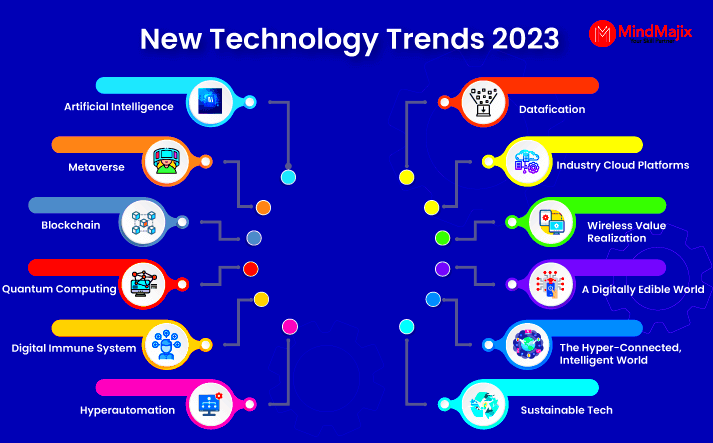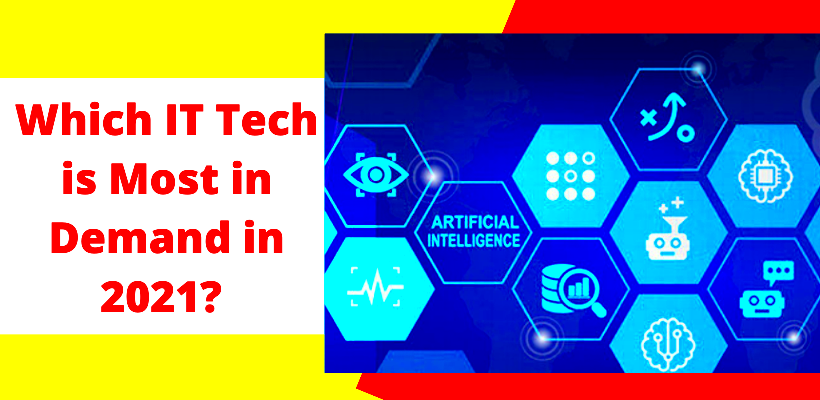The United States of America is witnessing such rapid change within its
technology sector characterized by cutting-edge developments that are transforming how companies do business and how individuals lead their lives.Currently, some IT technologies remain powerful drivers of this change thereby making them desirable for enterprises as well as individual practitioners. Cloud computing, artificial intelligence or cyber security are but examples among others at the center point of creativity. This article will discuss leading edge IT technologies popular in America today and indicate their effects on digital space.
Cloud Computing: A Key Trend in IT

In certain respects, this identifies the importance of cloud computing in the contemporary IT infrastructure. As such, companies can keep and reach their knowledge on the web at a cost that is less than others as it guarantees the most unmatched flexibility, scale-up and economy in management systems. Hence firm’s do not have to maintain servers physically leading to decreased costs while increasing effectiveness.Advantages associated with cloud computing consist of:
- Scalability: Easily scale resources up or down based on demand.
- Cost Efficiency: Pay only for the resources you use, reducing upfront hardware investments.
- Accessibility: Access data and applications from anywhere with an internet connection.
The leading cloud stage like Amazon Web Services (AWS), Microsoft Azure, and Google Cloud are overseeing the market by giving strong tools for computing, storage and networking to businesses. On the other hand, demand for cloud computing skills is also increasing as firms search for experts who can handle and fine-tune cloud based answers.
Artificial Intelligence and Machine Learning: Shaping the Future

Artificial intelligence (AI) and machine learning (ML) are no longer just futuristic concepts. They’re actively shaping industries across the USA, from healthcare to finance. AI refers to the development of machines that can mimic human intelligence, while ML focuses on systems that can learn from data and improve over time.The pivotal uses of artificial intelligence (AI) and machine learning (ML) comprise:
- Automation: Reducing manual labor by automating repetitive tasks.
- Predictive Analytics: Using data to predict future trends and behaviors.
- Personalization: Enhancing customer experiences through tailored recommendations and services.
Cybersecurity: Protecting Data in the Digital Age
Industry only linked with information
technology related to the world has greatly had an increase in cyber crimes where people lose money through advanced hacking techniques. These can range from the theft of money from ATM cards through hacking phone lines connecting to these cards, hacking email addresses containing online banking details to fiddling around with bank books before they are submitted for deposit approval.The aim often involves getting patient data or any financial documents that could help them evade taxes or carry out other fraudulent activities.As cyberthreats become increasingly complex, so do their costs. Cybersecurity is vital for national security and economic stability in the United States today. In the wake of a surge in online attacks and informational thefts, organizations are trying harder than ever before to shield confidential details about themselves. No sector is immune to these rising threats posed by hackers - it might be hospitals or banks who are being targeted most heavily nowadays.The central components of cyber safety comprise:
- Encryption: Protecting data by converting it into a code that can only be read by authorized parties.
- Firewalls: Monitoring and controlling incoming and outgoing network traffic to prevent unauthorized access.
- Authentication: Verifying the identity of users to ensure that only authorized individuals can access systems.
The need for specialists any seek to protect society from cybercrimes has reached an unprecedented level. Experts in this field carry out star-rated tasks including thwarting potential attacks, controlling hackers and securing think bank accounts among others.A lot of organizations that aim to preserve their data and networks will consider cybersecurity as one of their main aspects in the coming years as more people work from home while others are forced to adapt to e-learning approaches due to the pandemic outbreak.
Data Science and Analytics: The Power of Big Data
In technological circles, data is frequently dubbed as the “new oil” justifiably. While massive quantities of data are created and compiled by firms on a daily basis, it is only through its examination that one can derive true worth out of it. Data science and analytical procedures are essential for transforming unprocessed information into functional understandings thereby enabling organizations to make wise choices and remain relevant in business.The key areas in which data science and analytics find application are:
- Business Intelligence: Analyzing market trends to help businesses strategize and forecast future performance.
- Customer Analytics: Understanding customer behavior and preferences to improve services and products.
- Predictive Modeling: Using statistical techniques to predict future outcomes based on historical data.
Data scientists and analysts need tools such as Python, R, SQL, and platforms like Hadoop and Tableau. With the increasing dependency of companies on data for doing business, the need for professionals who specialize in data science and analytics is on the rise. This trend is likely to persist with the ever-growing volumes and complexities associated with data.
Blockchain: Revolutionizing Digital Transactions
The blockchain
technology has been transforming the manner in which online transactions are executed, providing for a safe and decentralised mode of documenting and confirming data. Although it was first given attention by virtual currencies such as Bitcoin, this distributed ledger system has other significant uses other than serving as a medium of exchange.It can find applications across various fields including supply chain management, and medical sciences whereby it enhances clarity and safety during operations that entail several players.Some of the major characteristics of blockchain
technology consist of:
- Decentralization: Eliminates the need for intermediaries like banks, as transactions are verified by a network of computers.
- Immutability: Once data is recorded on the blockchain, it cannot be altered or tampered with, ensuring data integrity.
- Transparency: All participants in a blockchain network have access to the same data, ensuring a high level of trust.
The ability of blockchain in enhancing security and transparency makes it a big darling for industries that deal with sensitive data like finance and health. Also, smart contracts that are self-executing contracts with the terms written directly in code are changing how agreements are made and enforced.As blockchain continues developing, its possible uses are growing thus leading to an increased requirement for experts who can comprehend this advanced
technology and apply it.
Internet of Things (IoT): Connecting the World
The Internet of Things (IoT) is revolutionizing how we engage with technology by linking common devices to the web. It is creating a world where devices connect with each other effortlessly, leading to improved efficiency and convenience through smart homes that have the potential of being tapped from a distance. In America, upsurge in IoT can be observed in sectors like health care, production and transport.The key applications of the Internet of Things comprise:
- Smart Homes: Devices like smart thermostats, lighting systems, and security cameras that can be controlled remotely via smartphones.
- Healthcare: Wearable devices that monitor vital signs and send real-time health data to doctors for remote monitoring.
- Industrial IoT: Sensors used in manufacturing to track equipment performance, predict maintenance needs, and optimize operations.
A great deal of opportunities are presented by IoT however at the same time it raises worries on privacy and data safety. It is important for anyone who connects these devices over internet that they need their data secure because most devices will generate lots of information that is going to be sent out through the web.Nevertheless, despite these difficulties, there is still a wide range of inventions which can be created with IoT improving people’s lives on daily basis.
Remote Work Technologies: Adapting to the New Normal
With the rise of remote work, especially after the COVID-19 pandemic, companies have had to adapt to new technologies that support a distributed workforce. Remote work technologies allow employees to stay connected, collaborate, and maintain productivity, no matter where they are.Some essential tools for working from home are:
- Video Conferencing Platforms: Services like Zoom, Microsoft Teams, and Google Meet help teams communicate face-to-face despite being in different locations.
- Collaboration Software: Tools like Slack, Trello, and Asana allow for seamless communication and project management.
- Cloud Storage: Platforms like Google Drive, Dropbox, and OneDrive enable teams to access and share files from anywhere.
Many experts have been given flexibility and work-life balance by remote work, yet it also faces its challenges. There are important issues such as ensuring data security, maintaining team morale, and avoiding burnout. However, remote work technologies are here to stay, allowing companies to function effectively in the "new normal."
Frequently Asked Questions about IT Technologies in the USA
What IT technologies are most in-demand in the USA?
The USA is experiencing a great demand for IT technologies such as cloud computing, AI, cybersecurity, data science and blockchain. All these technologies serve as a catalyst for innovation in different sectors.
Why is cybersecurity so important in today's digital age?
With more and more companies, as well as people going online to save their private information, risks of cyberattacks have gone up significantly. This makes cybersecurity a necessity to avoid these kinds of attacks on data since data breaches lead to huge losses and hurting the social image.
What industries benefit most from data science and analytics?
It really is very helpful to have industries like marketing, finance or healthcare guided by data science and analytics. In these sectors, data has been used for improved decision making, better customer experiences, as well as forecasting trends.
How does blockchain technology work?
Blockchain is a decentralized system that records transactions across multiple computers. Once a record has been placed on the blockchain, it is virtually impossible to make modifications. This gives the information enormous protection and clarity (emphasis on security and transparency).
Conclusion: The Future of IT in the USA
The future of IT in the USA is bright and full of potential, driven by continuous innovation in technologies like cloud computing, artificial intelligence, and cybersecurity. As businesses increasingly rely on digital solutions, the demand for skilled IT professionals will only continue to grow.Technologies like blockchain and the Internet of Things (IoT) are pushing boundaries, creating new opportunities and transforming industries. Staying informed and adaptable is key for businesses and professionals who want to thrive in this rapidly changing landscape.
 In certain respects, this identifies the importance of cloud computing in the contemporary IT infrastructure. As such, companies can keep and reach their knowledge on the web at a cost that is less than others as it guarantees the most unmatched flexibility, scale-up and economy in management systems. Hence firm’s do not have to maintain servers physically leading to decreased costs while increasing effectiveness.Advantages associated with cloud computing consist of:
In certain respects, this identifies the importance of cloud computing in the contemporary IT infrastructure. As such, companies can keep and reach their knowledge on the web at a cost that is less than others as it guarantees the most unmatched flexibility, scale-up and economy in management systems. Hence firm’s do not have to maintain servers physically leading to decreased costs while increasing effectiveness.Advantages associated with cloud computing consist of: Artificial intelligence (AI) and machine learning (ML) are no longer just futuristic concepts. They’re actively shaping industries across the USA, from healthcare to finance. AI refers to the development of machines that can mimic human intelligence, while ML focuses on systems that can learn from data and improve over time.The pivotal uses of artificial intelligence (AI) and machine learning (ML) comprise:
Artificial intelligence (AI) and machine learning (ML) are no longer just futuristic concepts. They’re actively shaping industries across the USA, from healthcare to finance. AI refers to the development of machines that can mimic human intelligence, while ML focuses on systems that can learn from data and improve over time.The pivotal uses of artificial intelligence (AI) and machine learning (ML) comprise:
 admin
admin








